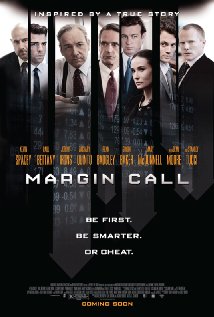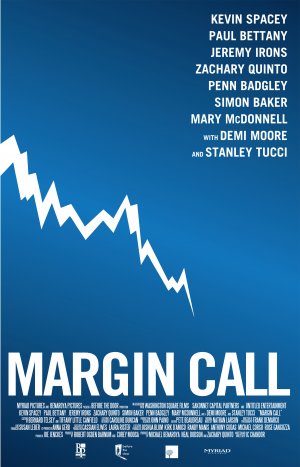How We Choose to Invest: Margin Call (The Movie)
By Asher Crispe: March 12, 2012: Category Inspirations, Living with the Times
Optioning our talents is a serious matter.
 Nominated for best screenplay in the 2012 Academy Awards, J.C. Chandor’s sleeper hit film Margin Call, elevates entertainment to the level of education. With its story spun around the recent financial crisis, we are placed at the epicenter of a drama of investment bankers whose greed and corruption comes straight out of the Darwinian school of Economics.
Nominated for best screenplay in the 2012 Academy Awards, J.C. Chandor’s sleeper hit film Margin Call, elevates entertainment to the level of education. With its story spun around the recent financial crisis, we are placed at the epicenter of a drama of investment bankers whose greed and corruption comes straight out of the Darwinian school of Economics.
As social commentary, the film is a more than an indictment of some unregulated business practices or absent business ethics. With the bulk of their investments irresponsibly levered, the market goes through a series of convulsions which take it far from equilibrium. The company’s trading algorithm fails as we are faced with the Big One—the ‘black swan’ event of a lifetime. The sky is falling.
To make matters worse, since no one likes the bearer of bad news, the top tier management decide to shoot the messenger who is the character of Eric Dale played by Stanley Tucci. Having caught a glimpse of the impending doom, only to be fired, the ‘prophet as analyst’ cannot fully deliver his warning to the people and retires back to his home where he begins to reevaluate everything in his life.
We catch back up with him much later in the film as the frantic team, scrambling to come to terms with the grim reality of an inescapable market maelstrom, is seeking answers. This one moment, sitting on the steps of his brownstone with his co-worker (Will Emerson as played by Paul Bettany), is for me the climax of blindness bumping into insight.
Here is the excerpt from the script:
ERIC
Did you know I built a bridge once?
WILL
Well…
ERIC
I was an engineer by trade.
It goes from Dilles Bottom, Ohio to Moundsville West Virginia. It spans 912 feet over the Ohio river. Steel through arch design. 12,100 people a day use the thing.
It cut out 35 miles each way of extra driving to get from Wheeling to New Martinsville. That’s a combined 847,000 miles of driving a day… and 25,410,000 miles a month and 304,920,000 miles a year saved.
Now ERIC’S mind is racing and he is adding up numbers as he goes.
ERIC (cont’d) I completed that project in 1986… 22 years ago. Over the life of that one bridge that’s 6 billion… 708 million… 240 thousand miles that haven’t had to be driven! At let’s say… 50 miles an hour that’s 134,164,800 hours… or 559,020 days… so that one little bridge has saved the people of those two communities a combined 1531 years of their lives not wasted in the car… give or take.
For many of us, trying to figure out what we are going to do in life is itself a lifelong pursuit. There are those who need a J-O-B, to bring home the bacon (or some suitable kosher substitute as the case may be). There are those for whom work is less tightly wound around necessity or may even be fully liberated from it. Far from keeping busy and filling time, our deepest desire in our (ideal) work is to climb to the top of Maslow’s hierarchy of needs and experience self-actualization.
How fortunate for those who can say: ‘Even if I had all of the money in the world and could retire, I would still get up and do what I do every day because I love what I do. This is who I am.’ Fringe benefits aside, it all comes down to finding that outlet for one’s indelible creativity, the means of gifting to the world what only that individual can deliver. Yet the sense of real accomplishment, the pride of making a difference to others, of positively impacting the world, somehow gets lost in the course of the rat race to the top of who knows what.
Eric traded in his talent as an engineer where he clearly had a positive impact on people as evidenced by his own quick calculation that he added an astonishing 1531 years of freedom from the drudgery of a long commute. Instead, he went after the big bucks which involved moving money around, attaching fancy names for unique financial products which are traded ad nausea. Clearly he is questioning whether or not this shuttling money back and forth has done the world any good—or at least the amount of clear and apparent good that building his bridge accomplished.
While we can debate the value and proper intentions of our financial institutions for years to come, I believe the example of the bridge reflects an even greater redemptive virtue.
In the introduction of the Genesis narrative we read about the week of Creation. The sages of the Talmud see this as the timeless model for the broad sweeping arch of history. The seven days becomes representative of seven thousand years of history with the 7th denoting the Sabbath as the Messianic age. We are now in the 6th millennium (5772 as of this writing). The Kabbalists teach that each day and its thousand year counterpart has some key allusion or hint to the character of that time frame. Since it is on the 6th day of the week that a person becomes more highly focused on the Sabbath preparation, it follows that there would be a parallel with the 1000 year period that we are in now.
The nature of this allusion is found in the Hebrew letter which signifies 6 and when written in large form (vav rabati) it can denote 6,000. This is the letter vav (ו). Vav, in addition to having a numerical value also has a meaning according to its name: a hook. Grammatically a vav can be used for conjunction and is usually translated as “and”. Even graphically a vav looks like a connector.
What do we learn from all of this?
For the kabbalists, this entire time period is one of building bridges both physical and spiritual. Our reality and world must become hyperlinked and interconnected. Moreover, it is not just about joining disconnected spaces. We must also forge temporal bridges. We must investigate the interplay between space and time and the mutual effect that they have on one and other.
A quick survey of the historical progress in this direction—from the age of sailing ships circumnavigating the globe, to the laying of railroad track and the paving of highways—reconfirms our experience of shrinking distances and dilated time. Six months of hazardous journey on a wagon has been compressed to a few hours on a jet. And this is just with physical travel.
There are many other extensions of our minds and bodies that allow for degrees of virtualization of remote places with the accompanying shrinkage of time intervals. Witness all of the teletechnologies: telegraph, telephone, telescope, television, etc….
Enter the web.
2011 saw the world cross a critical threshold—there are now 2 billion individuals joined in cyberspace with an expectation of 3 billion more joining them in the next few years. Already, the mighty cell phone connects the vast majority of the world’s population today.
In their recent book Abundance: The Future is Better Than You Think, Steven Kotler and Peter Diamandis point out that:
Right now a Masai warrior with a cellphone has better mobile phone capabilities than the president of the United States did twenty-five years ago. And if he’s on a smart phone with access to Google, then he has better access to information that the president did just fifteen years ago.
We are even creating an internet of things with everything from superstore products to house keys being linked with low cost RFID tags so that we can have real-time inventory and can GPS misplaced personal items inside our homes.
So what does it all boil down to?
Bridges through space and time that allow for the emergence of a Global village and a tightly woven world.
In Kabbalah, the sixth day or 6th millennium is also associated with the dimension of the soul known as Yesod which means foundation. The different soul dimensions have their own mapping onto the body and in this case, yesod corresponds to the procreative organs. Keeping in mind the kabbalists’ insistence on abstracting from anthropomorphized imagery, we can decode the figurative function of yesod as the channeling of our creative energies, the ability to externalize all of our inner riches in order to self-actualize. Clearly, the image evokes the creative connections of sexual congress.
What this amounts to is a fantastic picture of our modern technological world and the extensive innovation that is happening all around us. To add real value, we must link up persons and places, ideas and energies in ever closing intervals of time. The Sabbath experience is ushered in as the result of the tipping point wherein we reach a critical number of links or connections. All places become a unified domain. All times co-present.
Bridges are a great investment.
How We Choose to Invest: Margin Call (The Movie),















;)
;)
;)
;)
;)
;)
;)
;)
;)
;)

Have missed your articles! Glad you are able to share again.
Thanks! We hope to have many more to come!